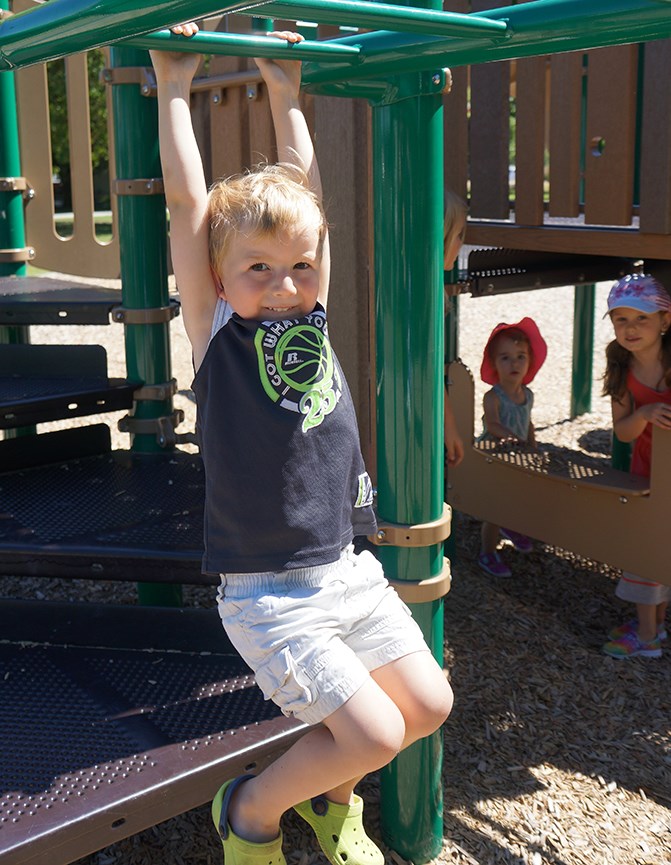The kids in Squamish aren’t as all right as they could be.
A recent study found that overall, five-year-olds in the district are trending downwards in their ability to reach important early developmental milestones.
B.C. organization Human Early Learning Partnership (HELP), based at the University of British Columbia has been conducting a survey in B.C. for the past 14 years. The survey measures kindergarten students’ vulnerability on one or more Early Development Instrument (EDI) markers, which include emotional maturity, physical health and well-being, and social competence.
The recent research was collected between 2011 and 2013.
For local children, “There wasn’t a lot of good news,” said Lianne Carley, policy consultant for population health with Vancouver Coastal Health, who presented the report at the Squamish Seniors’ Centre on June 17.
Comparison of the latest results to previous survey results offers a snapshot of how different groups of students in a neighbourhood are doing over time. The lower a neighbourhood’s overall EDI rate is, the better.
The recent report showed the worst overall neighbourhood in B.C. was Gold Trail at 54 per cent while the best neighbourhood was Murrayville in Langley at four per cent.
Squamish south, which includes Valleycliffe, was at 44 per cent vulnerability and Squamish north, which includes Garibaldi Highlands and Brackendale was at 30 per cent. “Squamish south is on the uh-oh, getting kind of on the far end of the scale, but it hasn’t changed over time so that is the interesting thing,” said Carley.
Squamish north’s dramatic increase in vulnerability is concerning, according to Carley.
On the last survey, which was done from 2007 to 2009, Squamish north was at 18 per cent. “There is just this steady increase,” Carley said.
The reason these figures are important is because the EDI can predict how successful students are going to be later on, she said.
“So if they are on the wrong path, it can be corrected, but if it is not, then it has been shown to correlate with dropouts and substance use and all that stuff.”
There could be numerous factors as to why a certain neighbourhood trends downward, according to Carley, so a further drilling down to see the exact reasons should be done, she said.
Parents are very likely playing a role in the downward EDI trend, Carley said. “They’re tired, they maybe are not spending as much time with their kids,” she said. “Screen time, I think is having an impact.”
She said studies show there should be no screen time of any kind for children up to the age of two.Parents too may be spending too much time on their devices and not interacting with their kids, she said.
Creating more access to early childhood development programs, and providing more information about what is available for parents may help a community too, Carley said. “Parents don’t always know where to go or what is available,” she said.
In terms of social competence, being over scheduled is an issue both for parents, who feel stressed taking their children from activity to activity, and for youngsters, who are in controlled environments most of the time, according to Carley. “So what happens is when they aren’t outside playing just with other kids in just a more natural way they are not building social competence.”
Squamish south’s social competence improved since the last report at 19 per cent, down from 24 per cent in 2009.
Squamish north, however saw a dramatic drop in social competence. The neighbourhood was one of the top performing neighbourhoods in the province in 2007 in terms social competence, at four per cent vulnerability. In the latest survey, Squamish north’s social competency was at 15 per cent. “You want to look at what was happening before: was there a flood of money at that time that created really great environments for early childhood development?”
In terms of what the district can do, she said creating family-friendly, affordable housing is important, as is transit, good-paying local jobs, and poverty reduction.
“We need to do better,” said Mayor Patricia Heintzman of the report.
Because of the population growth the district facilities and support systems haven’t kept pace, she said. “So we are kind of playing catch up.”
From 2001 to 2011, the number of Squamish tykes grew by 32 per cent, from 1,200 to 1,600.
New Westminster has done some really creative things to support its young residents, according to the report.
The municipality has created 600 childcare spaces since 2009 and added five child development hubs to the community.
Heintzman said she would like to look into Squamish emulating some of what was done in the Royal City. “Maybe our recreation centre, in partnership with the schools, we could create something similar to these childhood development hubs,” she said.
Overall she said she wants to understand why there is a disconnect between the results of the Health Matters report that showed Squamish adults are thriving and this less positive report about Squamish’s youngest citizens.
She also said children’s needs should be woven into Squamish’s Official Community Plan.
Heintzman said she plans to have Carley present at an upcoming council meeting.




